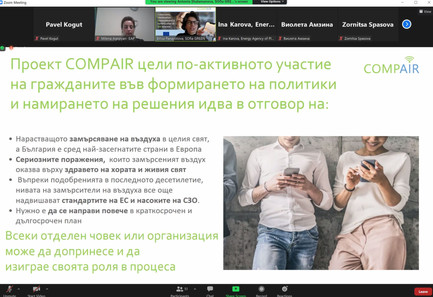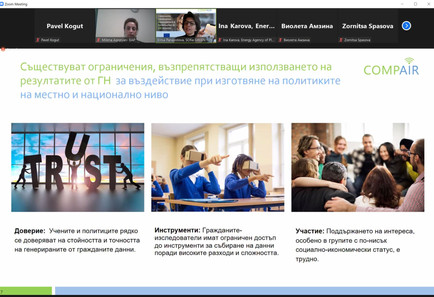COMPAIR Kicks Off Bulgarian Citizen Science Pilot With Co-Creation Workshop
- pavel874
- Feb 14, 2022
- 4 min read
During Covid-19 restrictions, many cities reported visible improvements in air quality. Of the main air pollutants, nitrogen dioxide (NO2) was affected the most during lockdowns due to drastic reductions in traffic, which is a major source of NO2. As the economy gradually rebounds, it is important that the issue of air pollution is not swept under the carpet, and that these palpable gains, however short-lived, become a catalyst for a lasting community-led action for clean air.
Recent workshops that took place in Athens, Berlin, Flanders, Plovdiv and Sofia are a step in this direction. They were organised by COMPAIR pilots to explore, together with urban stakeholders, the multidimensional issue that is air pollution. What are its main causes locally? How is it affecting the city, its inhabitants and the environment? What can citizen science do to address the problem? These were some of the questions discussed during workshops. As expected, responses and reflections varied from city to city, and we’re happy to present them to you in a series of articles summarising the main outcomes, starting with Sofia.
Air pollution in Sofia
Sofia is one of the most polluted capitals in Europe. There are more cars in Sofia than the average for the largest EU cities. Current trends show a constant increase in car usage whilst travel by public transport is declining. The city also suffers from high levels of fine particulate matter (PM10). Its main causes are not just emissions from combustion of gasoline, oil and diesel fuel, but also dust from construction sites, landfills, agriculture, wildfires, and bush/waste burning, among others (Dimitrova & Velizarova 2021).
To discuss how COMPAIR can help, the Bulgarian pilot organised the first exploratory workshop with representatives of local government, industry, research, and civil society. It was held online on 25 January 2022 and involved the use of Mentimeter to animate the discussion and collect instant feedback from participants.
Main findings
According to the participants, transport is the main source of air pollution, followed by domestic heating and street dust. The main vulnerable groups are children and young people, people with chronic diseases, groups that are energy-poor, as well as the elderly, pregnant women, cyclists, people working outdoors, and minorities. To understand how and where air pollution affects them, it would be important to have a good spatiotemporal view on the distribution of PM2.5, PM10, NOx, CO2, NO2, ultra-fine dust, diesel pollution, smog, and various aerosols, among others. To achieve that, sensors would need to be placed at key intersections, close to schools, and near the national measuring stations, which would also aid the comparison and calibration of gathered data.
Achieving cleaner air in Sofia will require changes in air related policies. That, in turn, requires better data on the impact that air pollution is having on health and environment (both natural and built). Citizen science can help fill existing data gaps, however the issue of trust must be overcome before it can be used consistently for policy making. Different ways of achieving that include i) subjecting citizen science data to metrological control and standardisation, ii) using a scientifically sound methodology and making it available for others, in particular experts, to scrutinise, and iii) incorporating citizen science findings into popular science publications. As regards the last point, when disseminating to the general public, it’s important not to overlook vulnerable groups, some of which might not be digitally literate or have deep technical expertise. To reach and effectively communicate with them, special channels would have to be used e.g. neighbourhood meetings, interactive games, themed debates, easy-to-understand visuals and infographics.
Recommendations
At the end of the workshop, participants listed a number of things they would like to see implemented over the course of the project. These needs are effectively recommendations for COMPAIR that need to be implemented to make the Bulgarian pilot a success. The actual list includes several dozen requirements, but the main ones broadly fall into three categories, as presented below.
Air pollution measurements: There is a lot of information on how individual pollutants (from transport, household fuel etc.) affect health. But there is currently a lack of understanding of the cumulative impact of different types of pollution to which people are often exposed simultaneously. It would be nice to address this gap by showing the interplay of different pollutants and their cumulative impact on health through digital tools e.g. AR app, dashboard.
Sensor locations: Official monitoring stations fail to capture the situation with air pollution in urban micro environments. COMPAIR, with its network of low-cost sensing devices, can add considerable value in this regard, by measuring air quality near schools, busy intersections, metro stations and public transport stops. Equally important would be to measure air quality within buildings e.g. inside metro stations, cars, classrooms and people’s homes. COMPAIR will make sure that all these details are considered and reflected in the pilot operations plan to be submitted in the coming months.
Sharing the right messages: To mobilise citizens to do something about air pollution, it would be important to talk about co-benefits of clean air (e.g. better health, longer lives), otherwise restrictive measures (e.g. bans on the use of fossil fuels as a heating source) might have little effect. COMPAIR’s comms team would be well-advised to incorporate this recommendation into its dissemination strategy going forward.
To conclude, this workshop was the first in a long series of co-creation sessions that the Bulgarian team will organise over the next few years. If you live in Sofia or Plovdiv and believe these cities deserve better air quality, we would love to hear from you! Drop us a line here, indicating how you would like to contribute e.g. by collecting data, coming to workshops, receiving news about the project.











